
B Chennaiah, owner of a 14-acre farm in Yemmiganur mandal of Kurnool district in western Andhra Pradesh, with his wife Tayamma and their grandchildren, waiting for the Guntur-bound train at Tuggali station. Persistent drought in western Andhra Pradesh is forcing big and small farmers alike to give up agriculture and migrate to more prosperous regions in search of daily-wage work.
Tall and lanky Chennaiah, clad in a shirt and a pristine white pancha (dhoti), was heading to Guntur city in central Andhra, a 12-hour train ride from Tuggali. With him were his wife Tayamma, son, daughter-in-law and two grandchildren, all set to work on mirchi (chilli) farms for daily wages.
January to April is peak migration season from west Kurnool for those seeking work on Guntur’s chilli farms. Around 200 migrant workers–men, women and children–stood waiting on that platform for the same train that day in January 2019.
This would be Chennaiah’s first stint as a daily wager. He was a big farmer: Until the previous year, he had employed 20 workers on his 14-acre field in Yemmiganur mandal of Kurnool, on which he raised tomatoes, onions and red gram. He was also a farmer leader who had been elected chairperson of a local agriculture cooperative.
Recurring drought in Kurnool over the last five years, however, has left Chennaiah and his family with few options. Average rainfall in Yemmiganur has been falling over 11 years since March 2007, when the region in fact received 100 mm more than average. Last year alone he incurred a loss of Rs 50,000 on every acre, escalating his debts to Rs 10 lakh. Worse, all the 10 borewells on his farm had dried up.
Sankranti, the biggest harvest festival was just a week away, and Chennaiah’s heart was heavy at the thought of leaving home. “Povali, lekapote kadupu raadu,” he said grimly, meaning, “If we don’t go, we will all starve.“
Droughts are a fact of life in Rayalaseema, the arid western region of Andhra Pradesh comprised of the four districts of Kurnool, Anantapur, YSR Kadapa and Chittoor. Between 2000 and 2018, the region has seen 15 drought years, the last nine consecutive, according to data from the office of the Commissioner for Disaster Management published in the Agriculture Statistics report 2017-2018 for the state.
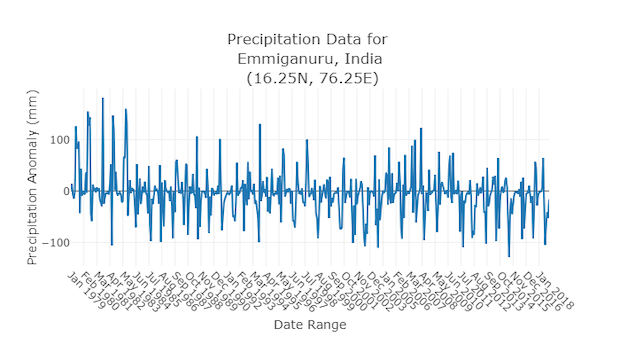
Source: NOAH, an application that tracks rainfall and surface water changes using satellite data.
Coming after consecutive drought years, 2018 brought the worst drought in 20 years. The state government declared 347 mandals (blocks) drought-affected in nine of 13 districts. Further, the entire state received 32% deficient rainfall between June 2018 and April 2019, affecting the main kharif and rabi (October to March, or winter) crops.
Today, agriculture holds no hope for small or big farmers in western Andhra Pradesh. Recurring droughts and the absence of alternative employment opportunities have forced hundreds of thousands of small, marginal and landless farmers, mostly from the Scheduled Castes/Tribes and Backward Castes, to migrate in the post-kharif (July-August monsoon cropping season) period, around Dussehra in October every year. They go in search of daily-wage jobs in agriculture or construction, both within and outside the state. In 2018, about 700,000 farmers migrated from Anantapur and Kurnool districts, reported the New Indian Express.
Drought has impacted close to 3.2 million farmers since 2014, resulting in losses of upto Rs 3,216 crore ($509 million)–money that could have been used to irrigate well over 40,192 hectares of land–The Hindu reported. Drought had damaged 550,000 hectares of farm land and affected 1.6 million small and marginal farmers between 2018 and 2019, according to a press release from the Chief Minister’s Office.
The cost of digging borewells and high pesticide prices are also pushing farmers into debt: 77% of Andhra’s rural agricultural households are in debt, the second highest in the country after Telangana (79%), higher than the national average of 52.5%, according to the latest data published by National Bank of Agriculture and Rural Development (NABARD).
Successive droughts have also brought drinking water shortage, hunger, child labour and sex trafficking of migrant workers.
This is the second part of our series that examines how ongoing drought across 42% of India’s land area is affecting people’s lives, and how governments are responding. For this part, we travelled to five districts–Anantapur, Kurnool and YSR Kadapa in the Rayalaseema region in the west, and Prakasam and Guntur in central Andhra Pradesh–all of which except Guntur have been declared severely drought-hit.
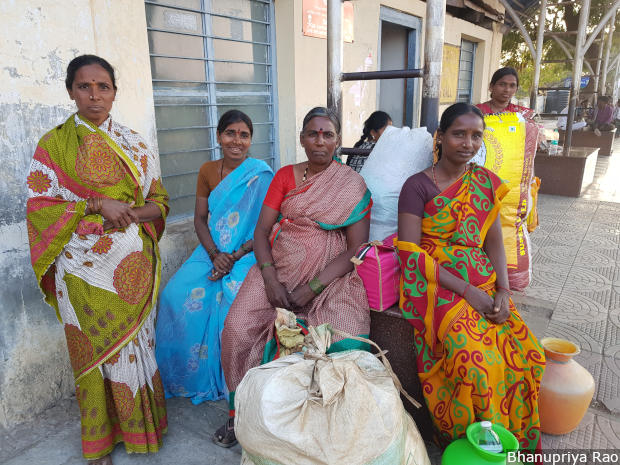
Umadevi, Manikyamma, Bharati, Lalithadevi (left to right) wait for the Hubbali-Vijayawada passenger train at Tuggali in Kurnool district. They have been travelling east to Guntur in search of wage work for the last 10 years. Recurring droughts and the absence of alternative employment has forced 200,000 farmers to migrate for daily wage jobs from Kurnool in the last year alone.
A land of contraries
The Rayalaseema region of Andhra Pradesh is a study in contrasts, with uneven irrigation and water facilities even within the same district. For instance, 37.35% of the total area is irrigated by canals in Kurnool district. However, canal irrigation is concentrated in the eastern region while the western regions are parched and have few irrigation facilities.
In Kadapa, the southern region of Rayachoti and Rajampeta are similarly devoid of water while other regions are irrigated. Similarly, 27.43% of the farm land in Prakasam district is irrigated by canals, which are concentrated in the eastern region, leaving the western part dependent on rainfed agriculture.
For the first time in 140 years, no sowing in Anantapur
Prakasam, the worst-affected district, received 58% deficient rainfall between June 2018 and April 2019. For the sixth consecutive year, all the 63 mandals in Anantapur district, where 64.4% of land area is desertified, have been declared drought-hit. The state government sought Rs 1,401 crore ($222 million) from the Centre, of which Rs 900 crore was released for drought mitigation in January 2019.

Rainfall has been increasingly erratic across Andhra Pradesh over a prolonged period, with increasing dry spells (seven consecutive days without rain), according to a Prakasam-based state hydrogeologist who did not wish to be named. Anantapur district has witnessed dry spells lasting 10-45 days in the last 25 years, severely affecting the yield of groundnut, the district’s main cash crop. Most of Andhra Pradesh, except the canal-irrigated districts of Krishna, Guntur, and east and west Godavari, depends on rainfed agriculture.
“For the first time in 140 years, a large majority of farmers have not sown anything at all last year in Anantapur,” said YV Mallareddy, director of Accion Fraterna Ecology Center, an NGO based in Anantapur. He has been studying drought patterns in the Rayalaseema region.
Dry spells are not the only problem, rains when they arrive are more intense now–upto 40 mm a day–eroding the soil.
Farmers in the districts that IndiaSpend visited have yet to receive any official communication from their mandal revenue officer (MRO) on whether their block has been declared drought- affected. “What does ‘declaring drought’ mean?” asked an angry S Chandrashekhar, a tenant farmer in Porumamillapalle in Cumbum mandal of Prakasam district. “Have they given us seeds, fodder or money?”
Farmers in several districts told IndiaSpend that they were yet to receive drought relief for 2017. The central government had released Rs 147 crore assistance for 2017 but it has yet to be distributed among farmers, The Hindu reported in August 2018.
The state government’s drought response has evolved over the years–from employment generation during droughts through the Food for Work programme in the 1960s to watershed programmes in the 1990s that involved building assets for water conservation and groundwater recharge through the Drought Prone Areas Programme.
An evaluation of the Andhra Pradesh Drought Adaptation Initiative, a collaborative pilot project between the World Bank and the state government, carried out in two districts of undivided Andhra Pradesh in 2006, found that new thinking and a participatory approach were needed to build long-term climate resilience. This would include income diversification, establishment of buffers of food grain, etc., and participatory management of groundwater.
In 2017, the government conceived the Andhra Pradesh Drought Mitigation Project, a Rs 1,103- crore ($175 million) project in 315 gram panchayats in the five drought-prone districts of Chittoor, Anantapur, Kurnool, Kadapa and Prakasam. In its pilot phase, the project integrates various components such as climate-resilient seeds systems, low-input farming, participatory groundwater management, regeneration of commons, livestock management and access to markets.
“While earlier programmes revolved around groundwater recharge, the issue of demand remained unaddressed,” explained A Ravindra, director of Watershed Support Services and Activities Network (WASSAN), the lead technical agency for executing the project. “This framework addresses the access issue by building systems of participatory groundwater governance.”
Despite groundwater crisis, government continues to encourage borewells
Nearly half of AP’s farmlands are dependent on groundwater sources–up from 37% in 2014 to 42.3% in 2017, according to the yearly Crop and Season Reports and the agriculture statistics published by the state government. In Anantapur and Chittoor districts, 90% and 86% of farms, respectively, use groundwater sources.
In 1969, borewells were introduced as the ideal solution for the state’s persistent drought problem but they have ended up creating acute groundwater shortage. The first policy push towards submersible (electric) borewells that are in use today came in 1998, during Chandrababu Naidu’s government in undivided Andhra Pradesh, when most open wells were closed under the Food for Work programme.
“Had these wells been left open, rains would have recharged the groundwater,” said the hydrogeologist who chose to remain anonymous. “Farmers were also happy to close these wells to save the 10 cents of land which could be used for cultivation. Today, water is not available even if you dig below 1,000 feet.”
As a result, groundwater levels have reached critical levels–there has been an average 4.02% decline between June 2018 and March 2019, the highest being in Chittoor and Kadapa (10.60%).

Between 1986 and 2013, deep borewells in the state increased by 2,716%, according to the 5th Minor Irrigation Census of the state government. In the five years to 2013, deep borewells multiplied by 73%. The government, through Indira Jalaprabha in 2009 and now NTR Jala Siri schemes, has been incentivising the use of borewells despite the deepening crisis.

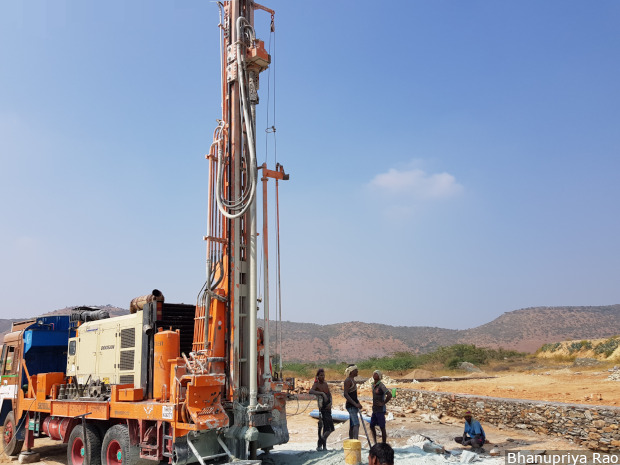
A borewell driller at work in Giddalur mandal of Prakasam district of central Andhra Pradesh. Despite critical groundwater levels, borewells and groundwater irrigation continue to be the mainstay in the drought-affected districts of AP as the government promotes them through schemes such as NTR Jala Siri.
Digging deeper, but no water
With government support for monocropping and horticulture and the push for borewells, over two decades, farmers shifted to more lucrative crops such as groundnuts and grapes even in water-starved Anantapur.
“Not just big farmers, even small and medium farmers are taking loans to invest in borewells in the hope that one good crop would be enough to clear their debt,” said C Bhanuja, the director of Rural and Environment Development Society (REDS), a Anantapur-based civil society organisation. “When borewells fail, they borrow more and get into deeper debt.”
Data show that semi-medium farmers (land holdings between 2 and 4 hectares) own a third of borewells while medium farmers (upto 10 hectares of land) own about 40%. Small farmers (1-2 hectares) own 14.9%.
“I dug the first borewell in 1998 after the government told us to, at a depth of 150 feet,” recalled B Linganna (64), a farmer in Aakaveedu village of Racherla mandal of Prakasam district. “Within five years, I had to rebore it further, going to a depth of 400 feet. Then 10 years ago, I had to dig deeper–to 700 feet–but water ran out in six months. Today, 80% of the borewells in this region have failed.”
After every one of his four borewells failed seven years ago, had no choice but to hack down all the sweet lime and mango trees on his eight-acre farm. He shifted entirely to sesame and castor, which are rainfed crops. In the last three years, these crops have failed due to severely deficient rains. This year, he harvested only half a quintal of sesame per acre and no castor. “Earlier, my heart would fill with joy when I looked at my farm,” he said. “Today, when I see it, I feel it is better to move on from this life.”
This is a familiar story across western Prakasam, where once-abundant fruit groves and rice and chilli farms have been laid bare. The tragedies that once played out only in Rayalaseema region–debt, migration and suicide–can now be seen across the state.
Between 2014 and 2019, 142 farmers in Prakasam district committed suicide, according to data provided by the state government in response to a Right to Information (RTI) request filed by farmers’ rights activist Kondal Reddy. In the past year alone, 60 of the 1,000 families in Aakaveedu village have migrated to Hyderabad seeking daily-wage work.
Between 2014 and January 2019, 530 farmers committed suicide in Anantapur district, according to state government data provided on an RTI request by the civil society organisation REDS. Most of these suicides were a result of heavy debts brought on by the expense of constructing borewells.
“The answer to this over-exploitation lies in regulating groundwater usage,” said Mallareddy. “We have the Andhra Pradesh Water, Land and Tree Act (WALTA) 2002 which lays down norms of groundwater usage but it is more honoured in the breach than in the observance.” He was among the experts who helped draft the Act.
Irrigation projects not delivering results
Relying on the 62 new irrigation projects the state government had announced since he came to power in 2014, chief minister Chandrababu Naidu declared in February 2019 that Andhra Pradesh would lead the nation in micro irrigation. But data show that 94.58% of minor irrigation schemes up to 2017-18 were focussed on groundwater, with the highest concentration in Prakasam (96.8%), Chittoor (95.7%) and Anantapur (94%).
Surface irrigation schemes, by contrast, constitute 5.42% of total irrigation schemes in the state.

The big irrigation projects in the state have run into problems. The Rs 1,300 crore ($206 million) Pattiseema lift-irrigation project linking the Godavari and Krishna rivers to provide water to parched Rayalaseema was criticised by the Comptroller and Auditor General (CAG) for wasting Rs 321 crore by not following contract norms.
The flagship Handri Neeva Sujala Sravanthi project meant to irrigate 600,000 acres in Rayalaseema is drawing farmers’ ire for its slow progress–critics allege that less than half the 100,000 acres meant to be covered in the first phase have been irrigated so far.
Modernisation work on the Tungabhadra High Level Canal (HLC), a major source of irrigation in Anantapur district, has been delayed by 10 years.
In November 2018, Naidu laid the foundation for the Rs 83,796 crore ($13.2 billion) Godavari Penna river linking project to provide water to the Rayalaseema region, but experts questioned the viability of drawing another 7,000 cusecs of water from the Godavari.
Some areas with canals passing through have inadequate access to water for drinking and irrigation, such as 13 villages of Mydukur mandal in Kadapa district that lie along the Telugu Ganga canal that flows to the Brahmasagar reservoir 12 km away, but provides no water for drinking or irrigation to the villages.
“This canal has been flowing since 1995 but we do not get water,” said Cheekiri Chinna Venkatasubbiah, the former sarpanch of Tipparedipalle, one of the villages and chairperson of the local primary agriculture cooperative society. “Until now we depended on rainfall and borewells but this year every source has failed. For the last 10 years, we have been constantly petitioning the government. Every year, they come and survey and nothing happens.”
“We need a lift irrigation project to provide canal water to the upland villages but the government has not sanctioned it,” said a project engineer with the Telugu Ganga project in Mydukur who did not wish to be named.
Their lands left fallow, farmers seek jobs in richer districts or other states
Migration from the Rayalaseema region has been rising steadily over the last five years. Farmers either head for chilli fields in Guntur or construction sites in Bengaluru, Hyderabad and Kerala. Farmers in Bomannapalle village in Madikera mandal of Kurnool district estimated that 30% of the fields in their village were fallow and 80% of farmers had moved to Hyderabad to work as municipal waste workers.
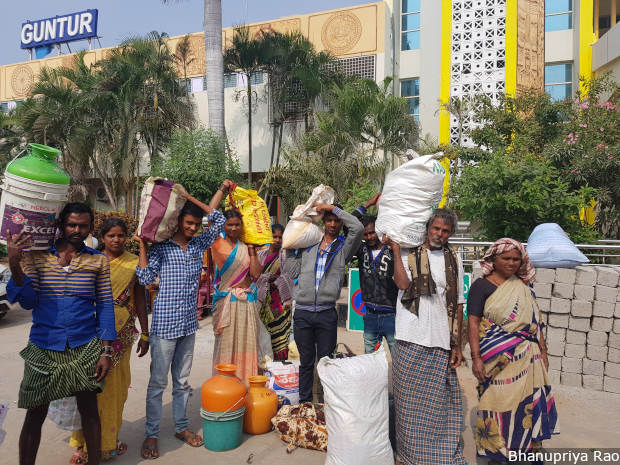
A group of migrant workers, who are small, medium and large farmers from Kurnool district, arrive at Guntur station on their way to chilli farms in this prosperous canal-irrigated district. “No rains, dry borewells, no crops. What choice did we have?” says Sekhamma (second from left), a single woman with two teenaged children, who has left behind a seven-acre farm in Gonegandla village in Kurnool district to work in Guntur.
On an early morning in January 2019, 200-odd migrant workers from Kurnool district alighted at the Guntur junction after a 12-hour journey spent standing. With their belongings stuffed into white plastic fertiliser bags–groceries, clothes, avakkai (pickles) and plastic water cans, men, women and children made their way to the chilli farms in the prosperous, canal-irrigated district. For the four months between January and April, the chilli farm where they work as daily-wage labourers would be their home.
“Varshalu levu, bore lo neelu levu, pantalu levu. Emi cheyyali [No rains, borewells dry, no crops. What could we do?],” said Sekhamma, a single woman with two teenaged children, who left behind a seven-acre farm in Gonegandla village in Kurnool district to work in Guntur.
While there are no official estimates, 200,000 people are estimated to have out-migrated from Kurnool district in 2018, 100,000 to Guntur district alone. 487,000 people from Anantapur district–a tenth of its population–have left, according to a civil society report from 2018.
Farmers are also selling their livestock to clear their debts; there is no fodder for the animals in any case. In the Dhone agriculture market in Kurnool district alone, livestock sales rose by 3.13% between November 2017 and December 2018, reported The Times of India. In the Cumbum lake region in Prakasam district, which once had abundant fodder, farmers are having to buy fodder at a higher price from the paddy-growing regions in Andhra Pradesh.
Guntur’s hardscrabble farms
At the chilli farms of Guntur, life is difficult. In Talacheruvu village in Atchampeta mandal, IndiaSpend met 30 families living in tarpaulin tents with no sanitation facilities. The settlement, on the periphery of a 30-acre chilli farm, offered little privacy. Women and girls were given a tiny enclosure to bathe.
“We left our comfortable homes to live in these cramped tents,” said K Mahalakshmi, a seasonal migrant worker from Aspari in Kurnool district who has been working at the same farm for six years now.
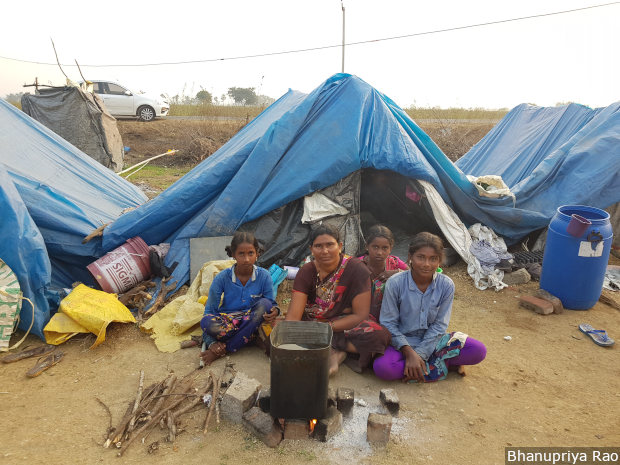
K Mahalakshmi, a seasonal migrant worker from Aspari in Kurnool district travels 380 km to Talacheruvu in Guntur in central Andhra Pradesh, every year for the past six years. The journey takes 12 hours. Migrant workers leave behind their comfortable homes and live in cramped tarpaulin tents on the periphery of the farm.
Over the years, the recruitment of migrant labour from Kurnool has turned into a well-oiled business. Every year, the big chilli farmers of Guntur district–those with 10-50 acres of land–pay an advance of upto Rs 3 lakh to a ‘mutha mestry’ (group head), a migrant worker himself, to recruit workers from his village. Each family is paid an ‘advance’ of Rs 5,000-Rs 10,000 depending on its needs and the sum is deducted from their wages.
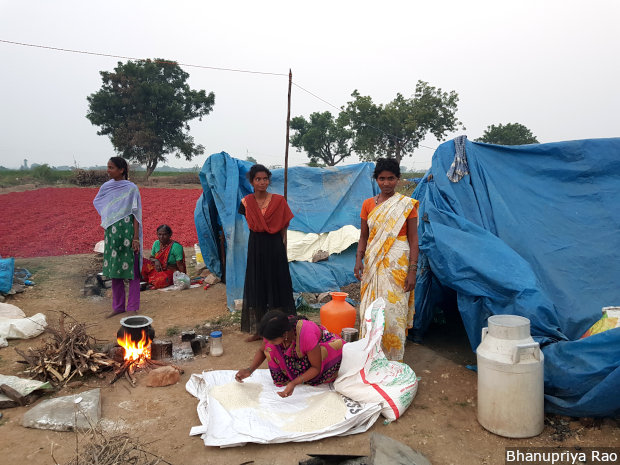
Women work a gruelling 10-hour shift on chilli farms in Guntur in central Andhra Pradesh, only to return to domestic work at their makeshift camp–heating water, washing clothes, making dinner.
“We are in no position to negotiate our wages,” said Shekamma, a worker. “Reddy [a generic caste name used for a big farmer] pays for our tent and water. He gives us our wages only at the end of the season. In between he gives us some money based on our needs.”
On Telangana’s cotton fields, where most migrant workers go between October and December, the wages are around Rs 7 for picking a kilo of cotton. This year the wages have been reduced to Rs 3 a kilo because of poor yield, as IndiaSpend reported in December 2018.
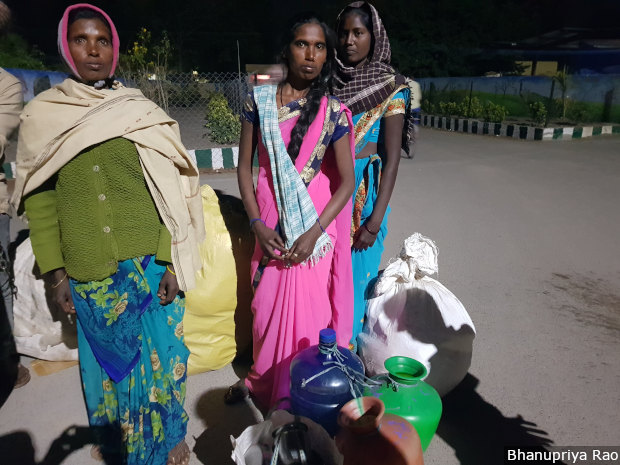
Nagamma, Suvarnamma, Narsamma (left to right) were just back from Vikarabad in Telangana when IndiaSpend met them at Adoni station in Kurnool district in western Andhra Pradesh. They had returned home after only 10 days because they had been paid only Rs 3 per kilo of cotton picked against the usual Rs 7 in previous years. Drought and farm distress in other regions affect the wages of farm workers.
“We have to pick 40 kilos of cotton a day to earn a decent wage so we often eat with one hand and pluck cotton with the other to make the most of our day,” said S Lalithamma, a worker in Aspari just back from Zaheerabad in Telangana after the cotton picking season.
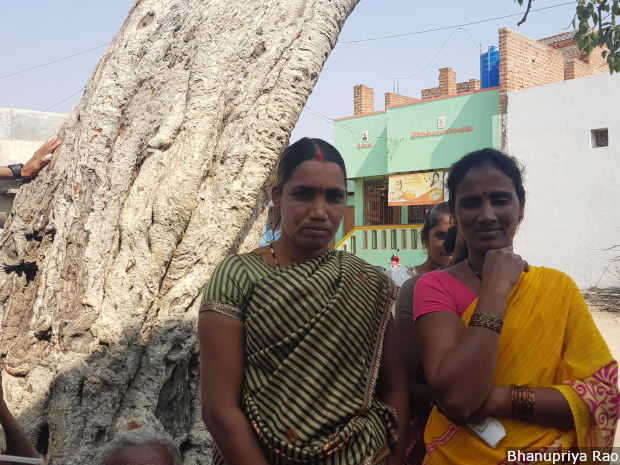
Lalithamma and Bhimakka (left to right) had returned to Aspari from Zaheerabad in Telangana in January 2019 after the cotton-picking season. Since cotton pickers are paid by the quantity they pick, they must pick a minimum of 40 kg a day to make a decent daily wage.
Chilli picking is also less rewarding this year after a pest attack damaged the crop in most parts of Guntur–daily wages are down from Rs 250 to Rs 200, a worker said. The minimum daily wage for agriculture labourers in Andhra Pradesh is Rs 285.90 for men and Rs 197.98 for women.
Job guarantee programme not working
Jobs under the Mahatma Gandhi National rural Employment Guarantee Scheme (MGNREGS) are hard to come by in drought-hit mandals. “This is because district administrations are not keen to open new works and give additional 50 days of work that workers from drought-affected regions are eligible for,” said Chakradhar Buddha, program manager of Libtech, an organisation leveraging digital technologies for improving public service delivery in India. “This affects Dalits [“lower” castes], Yanandis [a vulnerable tribe in Prakasam and Nellore districts] and single women who lose upto Rs 10,000 a year,” he said.
The government has recently revised the daily wage rate under MGNREGS in the state from Rs 205 to Rs 211 for the year 2019-2020.
There are large hoardings in these districts promoting MGNREGS and they feature the chief minister and his son N Lokesh, who is also the minister for rural development. “Unna Oorulo ne upadhi undaga, valasalaku enduku dandaga [Why migrate when there are jobs in your village],” the hoardings ask.
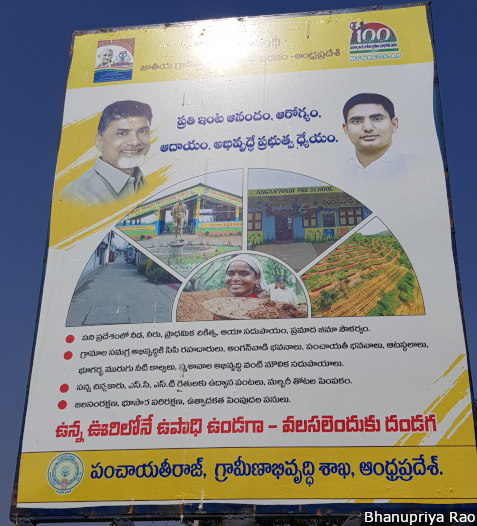
Poster promoting MGNREGS, featuring CM Chandrababu Naidu and his son N Lokesh, the rural development minister, in Prakasam district. “Why migrate when there are jobs in your village?,” the hoardings ask. Migrant workers in the drought-affected districts say the government has withheld new works under the scheme since October 2018 and delayed wage payments by more than six months.
“This is a joke,” said Bhimakka of Aspari in Kurnool district. “There is no MGNREGS work available since October last year and the government says new jobs will be available after March. We have not even been paid our wages for the last six months.” Pending wage payments have been delayed to the tune of Rs 911 crore in the state, according to state government data.
Chakradhar, the NREGA Sangharsh Morcha activist, accused the Naidu government of perverting the very idea of MGNREGS. “It has changed from a demand-driven, rights-based legislation where work should be available on demand to a top-down, techno-managerial process, where government creates jobs based on its whims and fancies,” he said.
The chief minister announced Annadatha Sukhibhava, an agricultural support programme, in February 2019, to give Rs 10,000 per annum to landowning farmers and Rs 15,000 per annum to tenant farmers. The government has identified 519,352 farmers and has initiated payments to 515,864 farmers. However, payments to tenant farmers have been delayed to the beginning of the kharif season post-elections, due to be held over April and May 2019, reported The Hindu. While farmers welcomed the monetary support, they really demanded water.
“Give us water. Give us a canal. Give us our freedom,” said Veeranagappa, a farmer with a medium-sized land holding in Pattikonda in Kurnool district, adding that the deputy chief minister, KE Krishnamurthy, represents the Pattikonda constituency in the state assembly (legislature). “Is our condition invisible to politicians?”
What drought and migration are doing to children
Mamatha (12) has just returned after a 10-hour shift picking Teja chillies–one of the hottest varieties–in Talacheruvu village in Guntur district. Her hands are burning but she has no time to rest because she has to also fetch water and help her mother cook dinner. “Chethulu manta vesina, attane chestamu [We continue to pick chillies even when our hands burn],” she said.
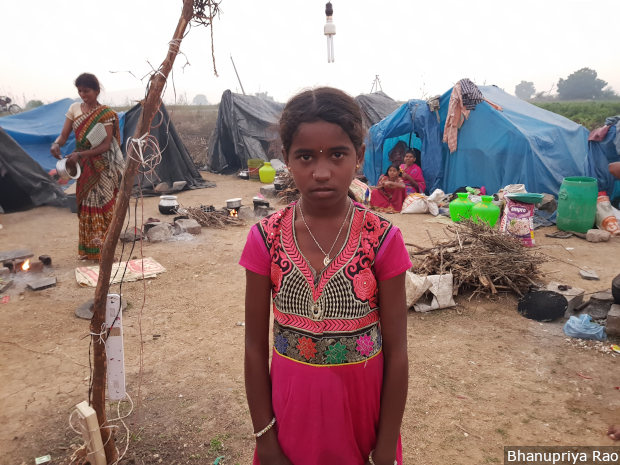
Mamatha (12) who has just returned after a 10-hour shift picking the hottest varieties of chillies in Guntur. Around 40% of farm workers on Guntur’s chilli farms are children, who have to work in extreme heat conditions and are out of school for the most part of the migration season from October to May.
Children make for about 40% of the farm labour at work in Guntur’s chilli farms. A survey conducted in three mandals of Atchampeta, Krosuru and Bellamkonda in Guntur district by a local NGO, LEAF, in 2018 found 20,000 children working on farms. Summers here, when temperatures rise to 47 degrees Celsius, can be especially hard on these children.
“Only when the four of us work can we earn Rs 70,000 in the four months we are here. This is the sum that can feed us for the rest of the year and pay off only the interest amount on our loans,” said Guntamma (35), a farm worker from Gonegandla in Kurnool. Her two children, Veerender (12) and Malleswari (7), work with her.
Of the 600 children enrolled in a government high school in Aspari mandal, 100 had migrated with their families in search of work, we found. Some 50 of the 160 children enrolled in classes 9 and 10 had dropped out after their families had migrated.
“Attendance levels drop after the crop season ends in August when many families migrate,” said the school headmaster. “The children return in December to sit for their half-yearly exams, after which they go back and then return for the final exams in March. We have instructions from the district education office not to detain any children though their attendance levels are 30-40%.”
LEAF has been lobbying with the mandal education officer at Atchampeta Mandal in Guntur to start night schools for the migrant children. “They refused, saying that it is Kurnool district’s problem not ours,” said A. Satyanarayana, who heads LEAF.
IndiaSpend wrote to the district collectors of Kurnool and Guntur asking if any measures were being taken for the welfare of migrant children. This report will be updated when they respond.
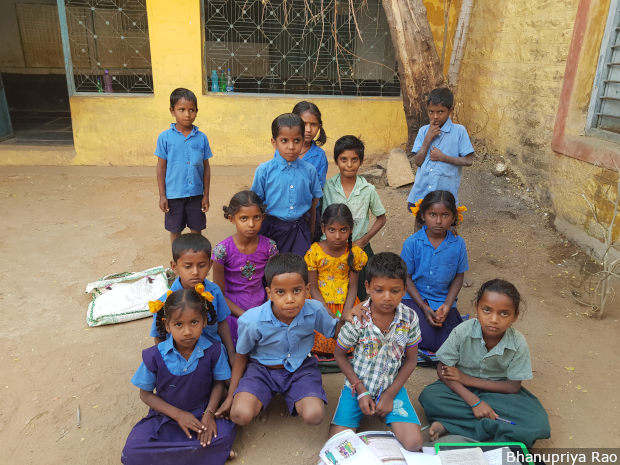
Children left behind by migrant parents at a seasonal hostel in Kairuppala village in Aspari mandal of Kurnool district in central Andhra Pradesh. The district administration in collaboration with NGOs has started 67 seasonal hostels that can accomodate 50 children each, as a temporary measure in 2019.
The Kurnool district administration has started seasonal hostels run by NGOs as temporary relief. “We have started 67 seasonal hostels in the first phase of drought mitigation in Kurnool district, which will accommodate 50 children each. We plan to open 87 more in the second phase,” said Vidyasagar, the head of the AP Samagra Shiksha Abhiyan. But we found that at the seasonal hostel in Kairurppala village in Aspari mandal, children are offered no facilities except dinner and lunch.
“This is mismanagement and we will take strict action,” said Vidyasagar when IndiaSpend brought the facts to his notice, “But usually kids prefer to stay at home with their grandparents.”
Hunger, exploitation–women and children bear the brunt
Life can be difficult for children who stay back. “Pillalu pastu untaru [The children are always hungry here],” said Sudhakar Reddy, a primary school teacher in Kareddipalle in Kadiri mandal of Anantapur, a tribal thanda (hamlet) inhabited by the Lambada community.
Children as young as six are left behind with aged grandparents when parents migrate to Kerala, which has strict rules against child labour.
Ten-year-old Jyoti gets up at 5 am and cooks for herself, her brother and her avva (grandmother), something she has been doing since she was six. “Annam, gojju, rasam anni chesthanu [I cooked rice, curry and rasam],” she said. When the “store biyyam” (subsidised rice under the public distribution system (PDS)) runs out, she and her brother Murali will carry 6 kg rice bags each on their backs from the nearest PDS store, 3 km away.
“When rice runs out in their homes kids go hungry for days,” said Sudhakar Reddy. “For most of these children, the school mid-day meal is the only meal for the day. This is why the first thing I do is serve them their meal when they arrive at 11 am.”
“We have petitioned the district administration to have local distribution centres in these villages with high migration [rates] so that children do not have to walk [long to fetch it], but the government has done nothing,” said C Bhanuja, the director of REDS, a local NGO.
Trafficking of young girls and women is common in these drought-prone districts. “Young girls are lured out of villages on the pretext of being sent for domestic work and then sold off to brothels in Delhi, Bombay and the Gulf countries,” said Bhanuja, who said she has rescued trafficked women in Kadiri mandal in Anantapur district.
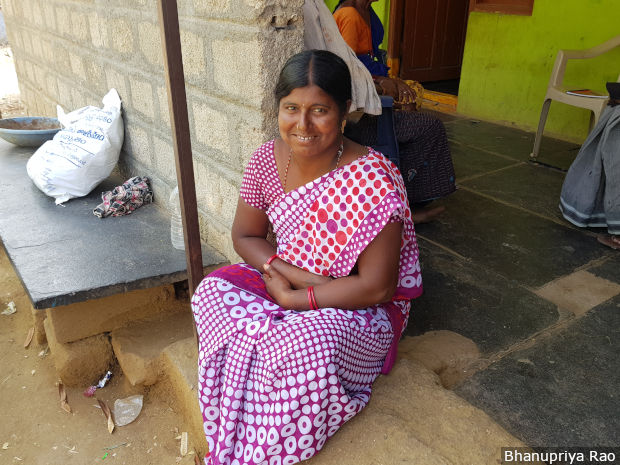
Adamma Nayak of Kareddipalle village in Anantapur district, who had been going to Kerala for construction work for the last 10 years, has decided to stay back in her village this year to ensure the safety of her daughter, Shyamala. Trafficking of young girls and women is common in the drought-affected areas. They are sold to brothels in Delhi, Bombay and the Gulf countries.
Adamma Nayak (40), of Kareddipalle in Anantapur district, who has been going to Kerala for the last 10 years, has decided to stay back this year to look after her 16-year-old daughter, Shyamala. “I cannot escape this poverty, I may earn only Rs 200 here and many days there is no work,” she said. “But at least, I can now ensure my daughter’s safety.”
(Rao is an independent researcher based in Hyderabad. Follow her on Twitter @bhanupriya_rao)
We welcome feedback. Please write to respond@indiaspend.org. We reserve the right to edit responses for language and grammar.
Courtesy: India Spend
